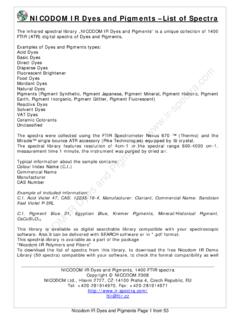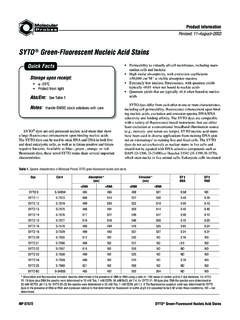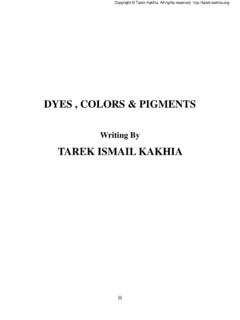Transcription of PROCEDURES AND CRITERIA ANALYSIS OF …
1 PROCEDURES AND CRITERIA ANALYSIS OF FLUORESCENT dyes IN WATER AND CHARCOAL SAMPLERS: FLUORESCEIN, EOSINE, RHODAMINE WT, AND SULFORHODAMINE B dyes Revision Date: March 3, 2015 Thomas Aley, PHG, PG President and Shiloh L. Beeman, PG Sr. Hydrogeologist Ozark Underground Laboratory, Inc. 1572 Aley Lane Protem, Missouri 65733 417-785-4289 Ozark Underground Laboratory, Inc. PROCEDURES AND CRITERIA March 3, 2015 Fluorescent Tracer Dye ANALYSIS -2-INTRODUCTION This document describes standard PROCEDURES and CRITERIA currently in use at the Ozark Underground Laboratory (OUL) as of the date shown on the title page. Some samples may be subjected to different PROCEDURES and CRITERIA because of unique conditions; such non-standard PROCEDURES and CRITERIA are identified in reports for those samples. Standard PROCEDURES and CRITERIA change as knowledge and experience increases and as equipment is improved or up-graded. The OUL maintains a summary of changes in standard PROCEDURES and CRITERIA .
2 TRACER dyes AND SAMPLE TYPES Dye Nomenclature Dye manufacturers and retailers use a myriad of names for the dyes . This causes confusion among dye users and report readers. The primary dyes used at the OUL and described in this document are included in Table 1 below. Table 1. Primary OUL Dye Nomenclature. OUL Common Name Color Index Number Color Index Name Other Names Fluorescein 45350 Acid Yellow 73 uranine, uranine C, sodium fluorescein, fluorescein LT and fluorescent yellow/green Eosine 45380 Acid Red 87 eosin, eosine OJ, and D&C Red 22 Rhodamine WT None assigned Acid Red 388 fluorescent red (but not the same as rhodamine B) Sulforhodamine B 45100 Acid Red 52 pontacyl brilliant pink B, lissamine red 4B, and fluoro brilliant pink The OUL routinely provides dye for tracing projects. dyes purchased for groundwater tracing are always mixtures that contain both dye and an associated diluent. Diluents enable the manufacturer to standardize the dye mixture so that there are minimal differences among batches.
3 Additionally, diluents are often designed to make it easier to dissolve the dye mixture in water, or to produce a product which meets a particular market need (groundwater tracing is only a tiny fraction of the dye market). The percent of dye in as-sold dye mixtures often varies dramatically among manufacturers and retailers, and retailers are sometimes incorrect about the percent of dye in their products. The OUL subjects all of its dyes to strict quality control (QC) testing. Table 2 summarizes the as-sold dye mixtures used by the OUL. Ozark Underground Laboratory, Inc. PROCEDURES AND CRITERIA March 3, 2015 Fluorescent Tracer Dye ANALYSIS -3-Table 2. As-Sold Dye Mixtures at the OUL. OUL Common Name Form Dye Equivalent Fluorescein Powder 75% dye equivalent, 25% diluent Eosine Powder 75% dye equivalent, 25% diluent Rhodamine WT Liquid 20% dye equivalent, 80% diluent Sulforhodamine B Powder 75% dye equivalent, 25% diluent Analytical results are based on the as-sold weights of the dyes provided by the OUL.
4 The use of dyes from other sources is discouraged due to the wide variability of dye equivalents within the market. However, if alternate source dyes are used, a sample should be provided to the OUL for quality control and to determine if a correction factor is necessary for the analytical results. Types of Samples Typical samples that are collected for fluorescent tracer dye ANALYSIS include charcoal samplers (also called activated carbon or charcoal packets) and water samples. The charcoal samplers are packets of fiberglass screening partially filled with grams of activated coconut charcoal. The charcoal used by the OUL is Calgon 207C coconut shell carbon, 6 to 12 mesh, or equivalent. The most commonly used charcoal samplers are about 4 inches long by 2 inches wide. A cigar-shaped sampler is made for use in very small diameter wells (such as 1-inch diameter piezometers); this is a special order item and should be specifically requested in advance when needed.
5 All of the samplers are closed by heat sealing. In specialized projects, soil samples have been collected from soil cores and analyzed for fluorescent tracer dyes . Project-specific PROCEDURES have been developed for projects such as these. For additional information, please contact the OUL. FIELD PROCEDURES Field PROCEDURES included in this section are intended as guidance, and not firm requirements. Placement of samplers and other field PROCEDURES require adjustment to field conditions. Personnel at the OUL are available to provide additional assistance for implementation of field PROCEDURES specific to specialized field conditions. Ozark Underground Laboratory, Inc. PROCEDURES AND CRITERIA March 3, 2015 Fluorescent Tracer Dye ANALYSIS -4-Placement of Samplers Charcoal samplers are placed so as to be exposed to as much water as possible. Water should flow through the packet. In springs and streams they are typically attached to a rock or other anchor in a riffle area.
6 Attachment of the packets often uses plastic tie wires. In swifter water galvanized wire (such as electric fence wire) is often used. Other types of anchoring wire can be used. Electrical wire with plastic insulation is also good. Packets are attached so that they extend outward from the anchor rather than laying flat against it. Two or more separately anchored packets are typically used for sampling springs and streams. The placement of multiple packets is recommended in order to minimize the chance of loss during the sampling period. The use of fewer packets is discouraged except when the spring or stream is so small that there is not appropriate space for placing multiple packets. When pumping wells are being sampled, the samplers are typically placed in sample holders made of plastic pipe fittings. Brass hose fittings can be at the end of the sample holders so that the sample holders can be installed on outside hose bibs and water which has run through the samplers can be directed to waste through a connected garden hose.
7 The samplers can be unscrewed in the middle so that charcoal packets can be changed. The middle portions of the samplers consist of inch diameter pipe and pipe fitting. Charcoal packets can be lowered into monitoring wells for sampling purposes. In general, if the well is screened, samplers should be placed approximately in the middle of the screened interval. Due to the typically lower volume of water that flows through a well, only one charcoal sampler should be used per well. However, multiple packets can be placed in a single well at depths to test different depth horizons when desirable. A weight should be added near the charcoal packet to ensure that it will not float. The weight should be of such a nature that it will not affect water quality. One common approach is to anchor the packets with a white or uncolored plastic cable tie to the top of a dedicated weighted disposable bailer. We typically run nylon cord from the top of the well to the charcoal packet and its weight.
8 Do not use colored cord since some of them are colored with fluorescent dyes . Nylon fishing line should not be used since it can be readily cut by a sharp projection in the well. In some cases, especially with small diameter wells and appreciable well depths, the weighted disposable bailers sink very slowly or may even fail to sink because of friction and floating of the anchoring cord. In such cases a weight may be added to the top of the disposable bailer. Stainless steel weights are ideal, but are not needed in all cases. All weights should be cleaned prior to use; the cleaning approach should comply with decontamination PROCEDURES in use at the project site. Optional Preparation of Charcoal Samplers Charcoal packets routinely contain some fine powder that washes off rapidly when they are placed in water. While not usually necessary, the following optional preparation step is suggested if the fine charcoal powder is problematic. Charcoal packets can be triple rinsed with distilled, demineralized, or reagent water known to be free of tracer dyes .
9 This rinsing is typically done by soaking. With this approach, Ozark Underground Laboratory, Inc. PROCEDURES AND CRITERIA March 3, 2015 Fluorescent Tracer Dye ANALYSIS -5-approximately 25 packets are placed in one gallon of water and soaked for at least 10 minutes. The packets are then removed from the water and excess water is shaken off the packets. The packets are then placed in a second gallon of water and again soaked for at least 10 minutes. After this soaking they are removed from the water and excess water is shaken off the packets. The packets are then placed in a third gallon of water and the procedure is again repeated. Rinsed packets are placed in plastic bags and are placed at sampling stations within three days. Packets can also be rinsed in jets of water for about one minute; this requires more water and is typically difficult to do in the field with water known to be free of tracer dyes . Collection and Replacement of Samplers Samplers are routinely collected and replaced at each of the sampling stations.
10 The frequency of sampler collection and replacement is determined by the nature of the study. Collections at one week intervals are common, but shorter or longer collection frequencies are acceptable and sometimes more appropriate. Shorter sampling frequencies are often used in the early phases of a study to better characterize time of travel. As an illustration, we often collect and change charcoal packets 1, 2, 4, and 7 days after dye injection. Subsequent sampling is then weekly. The sampling interval in wells at hazardous wastes sites should generally be no longer than about a week. Contaminants in the water can sometimes use up sorption sites on the charcoal that would otherwise adsorb the dye. This is especially important if the dye might pass in a relatively short duration pulse. Where convenient, the collected samplers should be briefly rinsed in the water being sampled to remove dirt and accumulated organic material. This is not necessary with well samples.






